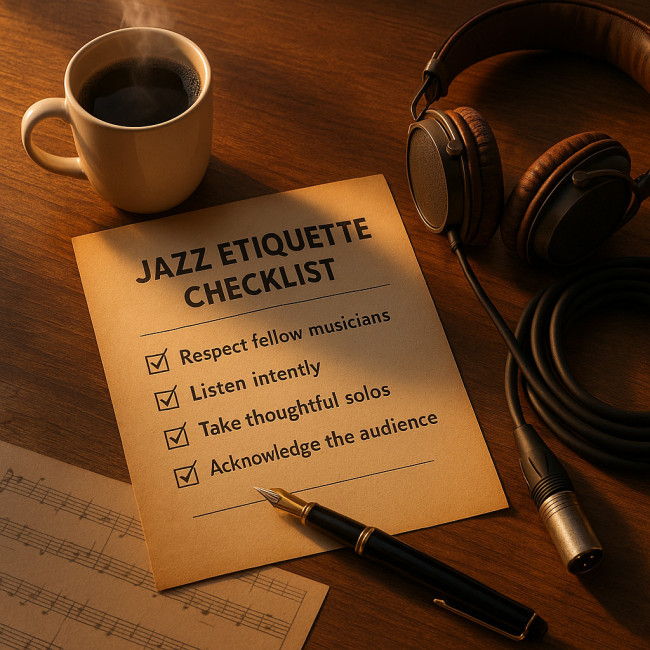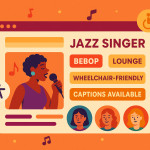Recording session etiquette: jazz vocalists and producers in perfect sync
Discover the unwritten rules that keep studio time flowing, budgets on track and artistic chemistry alive when jazz singers step up to the microphone. From pre-session planning to last-note follow-up, this guide equips both vocalists and producers with etiquette tips that turn every take into gold.
Why etiquette matters in the studio

A modern jazz recording session is a costly, high-pressure collaboration. A single hour can involve engineers, session players, an arranger and a producer—often at three-figure hourly rates. Clear etiquette eliminates friction, protects everyone's creative headspace, and ensures that a singer's tone, groove and storytelling shine through.
Pre-session groundwork: align goals before pressing “record”
Create a shared session brief
Producers should email a concise brief at least 72 hours in advance. Include:
- Keys, tempos and arrangement notes
- Reference tracks for tone and phrasing
- File-naming conventions for stems
- Expected vocal comps or scat-solo sections
Vocalists reply with confirmation of ranges, improvisation strengths and any health considerations (allergies, preferred tea, vocal-warm-up time). This upfront clarity cuts retakes by up to 40 % according to SoundBetter session surveys.
Schedule smartly
Book slots that respect vocal peak times—typically late morning or early afternoon when the voice is warmed but not fatigued. If multiple tunes are planned, sequence power belters before delicate ballads to preserve stamina.
Gear and file etiquette
• Producers: have two matching pop filters, fresh headphones and printed lyric sheets.
• Singers: bring a backup USB with lyric charts, personal in-ear tips, and a rough voice-demo reference for quick tone matching.
In-studio behaviour: the art of silent efficiency
Enter quietly, greet everyone by name
Studios can feel like surgical theatres. A low-key arrival maintains focus, especially if instrumentalists are fine-tuning levels.
Mic manners
- Wait for the engineer's cue before adjusting stand height.
- Keep hand gestures minimal to avoid cable noise.
- Maintain a consistent distance (thumb-to-pinky span) unless the producer suggests “working” the mic for dynamic effect.
Headphone etiquette
If the mix feels off, use concise language: “Could I get a little more piano at 2 kHz and a hair less reverb on my vocal?” Long, vague requests slow momentum.
Talkback discipline
Never speak over the control room once the take ends. Listen fully, note time-codes, then offer comments. This keeps feedback loops short.
Handling mistakes gracefully
Flubbed entrance? Say “Resetting bar 17 pick-up” so the engineer drops a marker instantly. Avoid apologising repeatedly; it drains morale faster than a flat note.
Producer responsibilities: creating a singer-friendly space
- Tone scouting: Spend five minutes running through vowel shapes to pick optimal EQ bands.
- Emotional briefings: Describe the desired mood with verbs (“lean,” “float,” “tease”) rather than vague adjectives.
- Silent gestures: Use hand signals for “one more take,” “punch-in” or “full pass” to reduce chatter.
Post-take etiquette: from playback to comping
Instant playback rules
Limit initial listening to the last chorus or problem spots. Full first-takes can be overwhelming and waste minutes.
Tag the keeper takes
Agree on a colour code in the DAW (e.g., green for potential masters, yellow for strong phrases). Vocalists should approve or veto within 15 seconds to keep the session moving.
Comping transparency
Producers must send a rough comp within 48 hours. Any melody edits outside slip edits or timing nips require explicit singer sign-off to avoid creative disputes.
Remote jazz sessions: extra etiquette layers
With high-speed fibre and real-time audio platforms, many jazz singers now cut takes from home. Follow these add-ons:
- Latency check: Run a 30-second click test and note round-trip latency in milliseconds.
- Redundant uploads: Deliver 24-bit WAV files via two cloud paths (WeTransfer + Drive) labelled with BPM and key.
- Camera on: Keep a muted webcam during takes so producers can spot posture and breath cues.
Common etiquette slip-ups—and quick fixes
| Slip-up | Impact | Fix |
|---|---|---|
| Arriving un-warmed | Extra 20 min setup | 15 min lip-trill routine pre-studio |
| Over-talking talkback | Confused punch-ins | Use hand signs, then speak |
| Unlabelled takes | Hours lost comping | Agree on file code: Song_Tempo_Key_Take# |
| Publicly posting rough mix | Legal risk, brand damage | Wait for NDA lift or release plan |
Cross-promotion etiquette: leverage directory visibility
Once masters are approved, both singer and producer should upload a 30-second clip to their professional jazz singer directory profile. Tag collaborators and session credits; directories reward completeness with higher search placement.
FAQ
- How early should a jazz vocalist arrive before a session?
- Plan to be in the lobby 30 minutes ahead. This covers paperwork, warm-ups and headset fitting without eating into booked time.
- What file format do producers expect for vocal stems?
- Industry standard is 24-bit/48 kHz WAV, mono, starting at bar 1 with two empty bars of count-in for easy alignment.
- Can I share behind-the-scenes photos on social media?
- Yes—once you have verbal clearance from the producer and no NDA restrictions apply. Avoid showing song titles on screens or lyric sheets.
Quick self-test: are you session-ready?
Next steps: lock in seamless sessions

Mastering etiquette is as crucial as fitting the perfect microphone. Review your own habits, bookmark this checklist and share it with collaborators. Producers: consider integrating these points into your onboarding docs. Vocalists: add an etiquette pledge to your one-sheet to stand out in competitive shortlists.
Ready to elevate your next jazz project? Book a discovery call today and turn pristine studio manners into chart-worthy recordings.
Further reading: streamline your live setup with this soundcheck essentials checklist.











